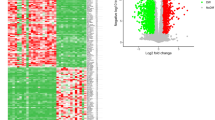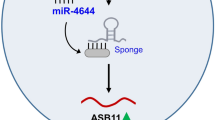Abstract
Recently, the incidence of melanoma has been on the rise. Patients with distant metastasis share poor prognosis. Increasing studies have been conducted to clarify the molecular mechanisms as well as to investigate potential effective therapeutic targets in the development of melanoma. This study focuses on the LncRNA UCA1 and its downstream regulated factors. In our experiments, UCA1 expression was discovered to be upregulated in melanoma tissues and cells, while the depletion of UCA1 led to the inhibition of cell proliferation, invasion and cell cycle arrest. To further our understanding of the mechanisms of UCA1, a system of experiments was built. We found that miR-507 could directly bind to UCA1 at the miRNA recognition site, and that there was a negative correlation between miR-507 and UCA1. Additionally, FOXM1 is a target of miR-507 and can be downregulated by either miR-507 overexpression or UCA1 depletion. Downregulated FOXM1 was analogous to the depletion of UCA1 and the overexpression of miR-507. These results, taken together, provide evidence for a novel UCA1 interaction regulatory network in tumorigenesis of melanoma.




Similar content being viewed by others
References
Aladowicz E, Ferro L, Vitali GC, Venditti E, Fornasari L, Lanfrancone L. Molecular networks in melanoma invasion and metastasis. Future Oncol. 2013;9(5):713–26.
Rahib L, Smith BD, Aizenberg R, Rosenzweig AB, Fleshman JM, Matrisian LM. Projecting cancer incidence and deaths to 2030: the unexpected burden of thyroid, liver, and pancreas cancers in the United States. Cancer Res. 2014;74(11):2913–21.
Weinstein D, Leininger J, Hamby C, Safai B. Diagnostic and prognostic biomarkers in melanoma. J Clin Aesthet Dermatol. 2014;7(6):13–24.
Cao B, Song N, Zhang M, Di C, Yang Y, Lu Y, et al. Systematic study of novel lncRNAs in different gastrointestinal cancer cells. Discov Med. 2016;21(115):159–71.
Sand M, Bechara FG, Sand D, Gambichler T, Hahn SA, Bromba M, et al. Expression profiles of long noncoding RNAs in cutaneous squamous cell carcinoma. Epigenomics. 2016;8(4):501–18.
Deng W, Wang J, Zhang J, Cai J, Bai Z, Zhang Z. TET2 regulates LncRNA-ANRIL expression and inhibits the growth of human gastric cancer cells. IUBMB Life. 2016;68(5):355–64.
Tian Y, Zhang X, Hao Y, Fang Z, He Y. Potential roles of abnormally expressed long noncoding RNA UCA1 and Malat-1 in metastasis of melanoma. Melanoma Res. 2014;24(4):335–41.
Yamamoto S, Inoue J, Kawano T, Kozaki K, Omura K, Inazawa J. The impact of miRNA-based molecular diagnostics and treatment of NRF2-stabilized tumors. Mol Cancer Res. 2014;12(1):58–68.
Schmitt AM, Chang HY. Long Noncoding RNAs in Cancer Pathways. Cancer Cell. 2016;29(4):452–63.
Bian Z, Jin L, Zhang J, Yin Y, Quan C, Hu Y, et al. LncRNA-UCA1 enhances cell proliferation and 5-fluorouracil resistance in colorectal cancer by inhibiting miR-204-5p. Sci Rep. 2016;6(23892):9.
Liu XH, Sun M, Nie FQ, Ge YB, Zhang EB, Yin DD, et al. Lnc RNA HOTAIR functions as a competing endogenous RNA to regulate HER2 expression by sponging miR-331-3p in gastric cancer. Mol Cancer. 2014;13:92.
Li Y, Wang T, Li Y, Chen D, Yu Z, Jin L, et al. Identification of long-non coding RNA UCA1 as an oncogene in renal cell carcinoma. Mol Med Rep. 2016;13(4):3326–34.
Nie W, Ge HJ, Yang XQ, Sun X, Huang H, Tao X, et al. LncRNA-UCA1exerts oncogenic functions in non-small cell lungcancerby targeting miR-193a-3p. Cancer Lett. 2016;371(1):99–106.
Hughes JM, Legnini I, Salvatori B, Masciarelli S, Marchioni M, Fazi F, et al. C/EBPα-p30 protein induces expression of the oncogenic long non-coding RNA UCA1 in acute myeloid leukemia. Oncotarget. 2015;6(21):18534–44.
Wang Y, Hou J, He D, Sun M, Zhang P, Yu Y, et al. The emerging function and mechanism of ceRNAs in Cancer. Trends Genet. 2016;32(4):211–24.
Tuo YL, Li XM, Luo J. Long noncoding RNA UCA1 modulates breast cancer cell growth and apoptosis through decreasing tumor suppressive miR-143. Eur Rev Med Pharmacol Sci. 2015;19(18):3403–11.
Myatt SS, Kongsema M, Man CW, Kelly DJ, Gomes AR, Khongkow P, et al. SUMOylation inhibits FOXM1 activity and delays mitotic transition. Oncogene. 2014;33(34):4316–29.
Sun Y, Yu X, Bai Q. miR-204 inhibits invasion and epithelial-mesenchymal transition by targeting FOXM1 in esophageal cancer. Int J Clin Exp Pathol. 2015;8(10):12775–83.
Tan X, Fu Y, Chen L, Lee W, Lai Y, Rezaei K, et al. miR-671-5p inhibits epithelial-to-mesenchymal transition by downregulating FOXM1 expression in breast cancer. Oncotarget. 2016;7(1):293–307.
Yuan F, Wang W. MicroRNA-802 suppresses breast cancer proliferation through downregulation of FoxM1. Mol Med Rep. 2015;12(3):4647–51.
Ito T, Kohashi K, Yamada Y, Maekawa A, Kuda M, Furue M, et al. Prognostic significance of Forkhead box M1 (FOXM1) expression and antitumor effect of FOXM1 inhibition in melanoma. Histopathology. 2016;69(1):63–71.
Miyashita A, Fukushima S, Nakahara S, Yamashita J, Tokuzumi A, Aoi J, et al. Investigation of FOXM1 as a potential new target for melanoma. Plos One. 2015;10(12):e0144241.
Sarkar D, Leung EY, Baguley BC, Finlay GJ, Askarian-Amiri ME. Epigenetic regulation in human melanoma: past and future. Epigenetics. 2015;10(2):103–21.
Acknowledgments
The authors are grateful to all staff at the study center who contributed to this study. This study was supported by a Grant from the Education Agency of Henan (No. 13A310671).
Author information
Authors and Affiliations
Corresponding author
Ethics declarations
Conflict of interest
The authors declare no conflict of interest or financial disclosures of this study.
Additional information
Yanping Wei and Qianqian Sun have contributed equally to this work.
Rights and permissions
About this article
Cite this article
Wei, Y., Sun, Q., Zhao, L. et al. LncRNA UCA1-miR-507-FOXM1 axis is involved in cell proliferation, invasion and G0/G1 cell cycle arrest in melanoma. Med Oncol 33, 88 (2016). https://doi.org/10.1007/s12032-016-0804-2
Received:
Accepted:
Published:
DOI: https://doi.org/10.1007/s12032-016-0804-2




